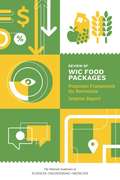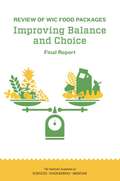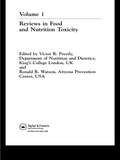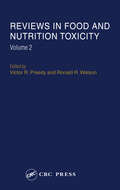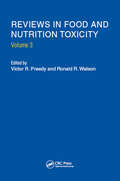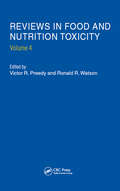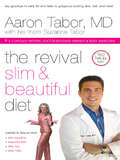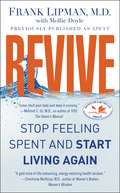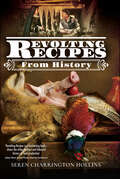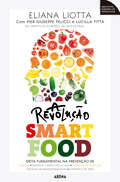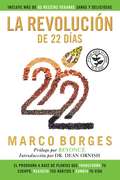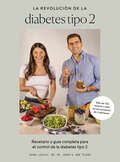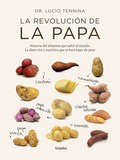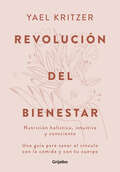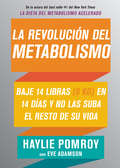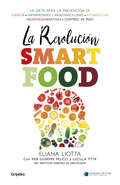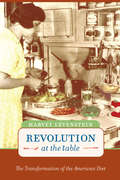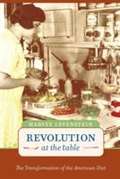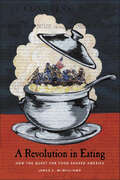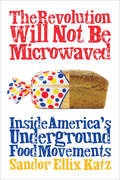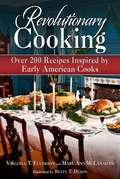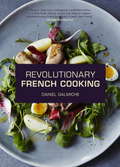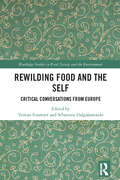- Table View
- List View
Review of WIC Food Packages: Interim Report
by National Academies of Sciences Engineering MedicineThe Special Supplemental Nutrition Program for Women, Infants, and Children (WIC) began 40 years ago as a pilot program and has since grown to serve over 8 million pregnant women, and mothers of and their infants and young children. Today the program serves more than a quarter of the pregnant women and half of the infants in the United States, at an annual cost of about $6.2 billion. Through its contribution to the nutritional needs of pregnant, breastfeeding, and post-partum women; infants; and children under 5 years of age; this federally supported nutrition assistance program is integral to meeting national nutrition policy goals for a significant portion of the U.S. population. To assure the continued success of the WIC, Congress mandated that the Food and Nutrition Service of the U.S. Department of Agriculture (USDA) reevaluate the program's food packages every 10 years. In 2014, the USDA asked the Institute of Medicine to undertake this reevaluation to ensure continued alignment with the goals of the Dietary Guidelines for Americans. This, the second report of this series, provides a summary of the work of phase I of the study, and serves as the analytical underpinning for phase II in which the committee will report its final conclusions and recommendations.
Review of WIC Food Packages: Final Report
by National Academies of Sciences Engineering MedicineThe Special Supplemental Nutrition Program for Women, Infants, and Children (WIC) began 40 years ago as a pilot program and has since grown to serve over 8 million pregnant women, and mothers of and their infants and young children. Today the program serves more than a quarter of the pregnant women and half of the infants in the United States, at an annual cost of about $6.2 billion. Through its contribution to the nutritional needs of pregnant, breastfeeding, and post-partum women; infants; and children under 5 years of age; this federally supported nutrition assistance program is integral to meeting national nutrition policy goals for a significant portion of the U.S. population. To assure the continued success of the WIC, Congress mandated that the Food and Nutrition Service of the U.S. Department of Agriculture (USDA) reevaluate the program’s food packages every 10 years. In 2014, the USDA asked the Institute of Medicine to undertake this reevaluation to ensure continued alignment with the goals of the Dietary Guidelines for Americans. In this third report, the committee provides its final analyses, recommendations, and the supporting rationale.
Reviews in Food and Nutrition Toxicity
by Victor R. Preedy Ronald R. WatsonFoot and mouth disease, CJD, GM, and fears about modern methods of food production have put food safety in the spotlight. In addition, the food industry is increasingly reliant upon technological innovation, requiring anyone connected with food safety to keep abreast of the key issues and advances. Reviews in Food and Nutrition Toxicity, Vo
Reviews in Food and Nutrition Toxicity, Volume 2
by Victor R. Preedy Ronald R. WatsonThis second volume of Reviews in Food and Nutrition Toxicity follows on directly from the successes of the first volume published last year. This series disseminates important data pertaining to food and nutrition safety and toxicology that is relevant to humans. Chapters in this series extend from the introduction of toxins in the manufacture or p
Reviews in Food and Nutrition Toxicity, Volume 3
by Victor R. PreedyIncluding the latest reviews of the most current issues related to food and nutrition toxicity, Reviews in Food and Nutrition Toxicity, Volume 3 distills a wide range of research on food safety and food technology. Put together by a strong team with a wealth of broad experience, the continuation of this important new series includes contributions f
Reviews in Food and Nutrition Toxicity, Volume 4
by Victor R. Preedy Ronald Ross WatsonReviews in Food and Nutrition Toxicity, Volume 4 includes the most recent reviews of current issues involved in the toxicity of food and nutrients. With contributors from the fields of medicine, public health, and environmental science, the continuation of this series distills a broad range of research on food safety and food technology. Vo
The Revival Slim and Beautiful Diet
by Aaron TaborA "no-brainer" system to better physical, emotional and spiritual health. Take a dynamic medical researcher and physician, pair him with his down-to-earth, straight-talking mama - and you've created the perfect writing team for The Slim and Beautiful Diet. Based on ground-breaking research, this book shares the exciting health benefits of soy along with other easy-to-implement life-enhancing beliefs, activities, thoughts and health practices in an entertaining, accessible format.
Revive: Stop Feeling Spent and Start Living Again
by Mollie Doyle Frank LipmanFrom the doctor whose "extraordinary practice is at the vanguard of a revolutionary way to deliver medical care" (O, The Oprah Magazine), an easy program to restore energy and health. DO YOU FEEL UNUSUALLY EXHAUSTED? DO YOU HAVE TROUBLE SLEEPING? DOES YOUR DIGESTION BOTHER YOU? DO YOU HAVE ACHING MUSCLES AND JOINTS? DO YOU FEEL LIKE YOU ARE AGING TOO QUICKLY? DO YOU FEEL LIKE YOU'RE RUNNING ON EMPTY? Fatigue, unexplained back and joint pain, distractibility, irritability, insomnia, and digestive problems leave many of us feeling spent -- and there is no pill that reverses the effects. Many Americans are plagued by this new epidemic, and doctors are unable to diagnose any single cause. But Dr. Frank Lipman knows that this profound feeling of general unwellness is not part of the normal aging process. In this revolutionary book, Dr. Lipman is the first to connect the dots in a constellation of symptoms, offering a proven solution to combat the pervasive syndrome he calls Spent. When someone is Spent, the body is doing everything it can to indicate that it is time to slow down, rest, detoxify, repair, replenish, and restore. Dr. Lipman has helped thousands of patients who suffer from Spent to revive their bodies -- and, in most cases, feel more energized and healthier than they ever have before. In Spent, Dr. Lipman first identifies the things in modern life that lead to energy depletion, such as stress, light deprivation, an erratic sleep schedule, and a diet high in sugar and processed foods. Next, he creates "Daily Beats," a series of simple actions -- such as sleep, diet, exercise, nutrition, meditation, and relaxation -- that readers can take to repair their stressed systems and nourish their bodies and minds. As with Dr. Lipman's patients, anyone following his day-by-day program will feel energized, vibrant, and younger. With a nutrition plan of tasty recipes photographs of research-based exercises and stretches, and wisdom from Dr. Lipman's thirty years of medical practice, Spent puts readers back in touch with their bodies' natural rhythms and introduces them to a lifetime of good health.
Revolting Recipes From History
by Seren Charrington HollinsNothing causes a stir on social media platforms like a topical discussion on the latest food trend. Modern-day chefs like to think that they are creative and often claim to push boundaries of food creation, but if we want to explore real culinary creativity then we need to look to our ancestors. Writer and food historian, Seren Charrington-Hollins delves into the history of culinary experimentation to bring us some of the weirdest and most stomach-churning food delicacies to ever grace a dining table. She uncovers the rather gruesome history behind some everyday staples, uncovers bizarre and curious recipes, whilst casting a light on foods that have fallen from culinary grace, such as cows udders and tripe; showing that revulsion is just a matter of taste, times and perhaps knowledge. From pickled brains to headcheese, through to song birds and nymph's thighs, this book explores foods that have evoked disgust and delight in diners depending on culinary perspective. So pull up a chair, unfold your napkin and get ready for a highly entertaining and enlightening journey to explore what makes a recipe revolting? Be warned; you’ll need a strong stomach and an open mind.
A revolução smartfood
by Eliana LiottaDieta fundamental na prevenção deCancro - Doenças cardiovasculares - Doenças metabólicasDoenças neurodegenerativas - Controlo de peso Este guia explica de forma clara e simples quais os alimentos, que quantidades e como deve ingeri-los para viver mais e melhor. Smartfood é:A primeira dieta europeia com um marco científico, o do célebre Instituto Europeu de Oncologia;Uma dieta para prolongar a vida, com 30 superalimentos que regulam o metabolismo e previnem o cancro e outras patologias;Uma dieta para perder peso, fácil de seguir e que não impõe grandes sacrifícios. O programa Smartfood, criado em colaboração com o reputado Instituto Europeu de Oncologia (IEO) de Milão, baseia-se em milhares de pesquisas e estudos avançados da nutrigenómica, a disciplina que identifica a relação entre o património genético e os alimentos. Sabe-se hoje que certos alimentos têm poder curativo e são capazes de cuidar e proteger o corpo. São eles os protagonistas do programa Smartfood; 30 superalimentos que não podem faltar na sua mesa, pois constituem os aliados perfeitos da saúde e da linha. São alimentos «smart» - brilhantes ou inteligentes -, porque a sua acção sobre o nosso corpo é extraordinária. Saciam, evitam a acumulação de gordura, previnem as doenças e prolongam a vida. Trata-se de alimentos comuns como a alface, os cereais integrais, os morangos ou os pistácios. Neste livro, Eliana Liotta explica de forma simples como introduzir estes alimentos na nossa dieta e revolucionar, com poucas mudanças, o nosso estilo de vida. Fácil de seguir, a dieta Smartfood propõe um método em duas etapas para abraçar uma alimentação mais saudável, sem sacrificar os hábitos alimentares. Os resultados? Para além de fazer perder os quilos a mais, esta dieta é fundamental na prevenção do cancro, doenças cardiovasculares, metabólicas e neurodegenerativas. Sobre A revolução smartfood:«A regra fundamental é não acreditar em milagres e perdas de peso drásticas, porque, depois de os eliminarmos, os quilos recuperam-se rapidamente e podem trazer com eles doenças e distúrbios. Esqueça os magos e gurus da moda e confie na ciência. Como no caso de A Revolução Smartfood, que recebe a 'bênção' do IEO, o Instituto Europeu de Oncologia.»Il Messaggero
La revolución de 22 días
by Marco Borges Beyoncé Dean OrnishUn programa innovador para crear un estilo de vida basado en plantas, diseñado para transformar tu salud mental, emocional y física en tan sólo 22 díasSi quieres perder peso, si quieres estar más en forma y más fuerte que nunca, ¡La revolución de 22 días es la respuesta! Basada en el principio de que tardamos 21 días en formar o en romper un hábito, "después de 22 días, ya has encontrado el camino", como señala Jay-Z: La revolución de los 22 días es un plan accesible para quienes buscan un estilo de vida más saludable, bajar de peso, o para revertir problemas serios de salud. Los beneficios de una dieta vegana no pueden ser subestimados, ya que se ha demostrado que ayuda a prevenir el cáncer, a bajar los niveles de colesterol, a reducir el riesgo de enfermedades del corazón, a disminuir la presión arterial, e incluso a revertir la diabetes.Como uno de los expertos en salud más solicitados de la actualidad, el fisiólogo del ejercicio Marco Borges ha pasado varios años ayudando a su exclusiva lista de clientes de alto perfil a cambiar permanentemente sus vidas y cuerpos a través de sus métodos innovadores. Celebridades como Beyoncé, Jay-Z, Jennifer López, Kanye West y Pharrell Williams, Gloria Estefan, Gwen Stefani y Shakira han recurrido a él por su experiencia.Ahora, por primera vez, Borges da a conocer su manifiesto codiciado y revolucionario, que ofrece los fundamentos integrales de comenzar una dieta basada en plantas. En el libro, encontrarás estrategias motivadoras, beneficios y consejos para mantener el rumbo, deliciosas recetas, y un plan detallado de comidas de los 22 días. Con este programa, tendrás una vida más sana, más energética, y más productiva, ayudándote a vivir la vida que deseas, y no sólo la que tienes.
La revolución de la diabetes tipo 2: Recetario y guía completa para el control de la diabetes tipo 2
by Diana Licalzi Jose TejeroDescubre cómo puedes revertir la causa raíz de la diabetes tipo 2 con esta guía innovadora y fácil de seguir, que incluye un régimen de comidas de 4 semanas y más de 100 deliciosas recetas a base de verduras ricas en fibra.Si tienes prediabetes o diabetes tipo 2, este método puede ayudarte a lograr niveles de azúcar en la sangre normales en cuestión de semanas. Los simples cambios en el estilo de vida que encontrarás en este libro se enfocan en revertir la resistencia a la insulina—la causa raíz de la diabetes tipo 2.Escrito por una dietista registrada y un fisiólogo del ejercicio, La revolución de la diabetes tipo 2 utiliza un programa revolucionario basado en ciencia que ofrece:Régimen de comidas por 4 semanas, diseñados para ahorrar tiempo en la cocinaListas de compras sencillas para cada semana y consejos para la preparación de las comidasMás de 100 recetas a base de verduras altas en fibra que ayudan a mantener tu nivel de azúcar en la sangre equilibrado Consejos sobre cómo crear una dieta equilibrada que incluye alimentos integrales y basados en vegetales, y carne si se desea Consejos para hacer las compras de alimentos y cómo leer las etiquetas nutricionales Orientación sobre cómo abastecer tu despensa y saber qué alimentos tener siempre a mano Lecciones útiles y consejos sobre cómo la nutrición, el ejercicio, el sueño y el estrés afectan tu salud relacionada con la diabetes Comienza a revertir la causa raíz de la diabetes tipo 2, reduce o elimina la necesidad de medicinas y disminuye tu nivel de azúcar en la sangre con La revolución de la diabetes tipo 2.Discover how you can reverse the root cause of type 2 diabetes with this innovative, easy-to-follow guide, which includes a 4-week meal plan and over 100 delicious, high-fiber, plant-based recipes.If you have prediabetes or type 2 diabetes, this approach can help you achieve non-diabetic blood sugar within weeks. The simple lifestyle changes outlined in this diabetes cookbook focus on the reversal of insulin resistance—the root cause of high blood sugar.Developed by a registered dietitian and exercise physiologist, The Type 2 Diabetes Revolution uses a revolutionary, science-based program to provide:Daily meal plans for 4 weeks, designed to minimize your time in the kitchenSimple grocery shopping lists for every week of the meal plan and tips for meal prep100+ high-fiber, plant-based recipes that keep your blood sugar balancedAdvice on how to create a balanced diet that includes plant-based, whole foods and meat, if desiredTips for grocery shopping and how to read nutritional labelsGuidance on stocking your pantry and knowing which to always have on handUseful lessons and tips on how nutrition, exercise, sleep, and stress impact your diabetes health Start reversing the root cause of type 2 diabetes, eliminate or reduce your need for medication, and lower your blood sugar with The Type 2 Diabetes Revolution.
La revolución de la papa: Historia del alimento que salvó al mundo. La dieta rica y nutritiva que te hará bajar de peso
by Lucio TenninaLa historia de un alimento con mala fama pero con propiedades increíbles: la papa. Ultra conocida y por eso mismo un poco relegada, este libro celebra su existencia, nos enseña sus propiedades y a cocinarla de la manera más sana. Incluye recetas y una dieta de dos semanas para bajar de peso. La papa tiene mala fama. Durante años y según las épocas, fue maltratada, mal entendida, prejuzgada. Todavía hoy, cuando se incorporan papas a una dieta para adelgazar, la expresión de estupor y de incredulidad aparece en los rostros de los pacientes. Sin embargo, el 79% de su composición es agua, y el resto, una maravillosa mezcla de carbohidratos, proteínas, vitaminas y minerales, además de ser uno de los alimentos con mayor capacidad de saciedad en el mundo. Este libro es una oda a la papa: celebra su historia, sus beneficios, y despeja los prejuicios, para que deje de formar parte de esa categoría de alimentos que se consideran "pesados" o "calóricos". Y para que vuelvas a incluirla en tu dieta no solo perdiéndole el miedo, sino tomando consciencia de su valor. El Dr. Lucio Tennina se propuso reivindicar a la papa. Nos enseña a prepararla de manera sana, potenciando su poder nutricional, y la convierte en la base de una dieta de dos semanas que te ayudará a bajar de peso.
Revolución del bienestar: Nutrición holística, intuitiva y consciente. Una guía para sanar el vínculo con la comida y con tu cuerpo
by Yael Kritzer¿Cómo es tu relación con la comida y con tu cuerpo? Posiblemente sea compleja, atravesada por mandatos, mitos y la sensación de que no estás haciendo las cosas bien. Sin embargo, otra forma de habitarlo es posible. En este libro vas a encontrar información sobre la ciencia de la nutrición desde una perspectiva holística, y también consejos y prácticas para transitar tu camino de vuelta al amor propio de forma consciente y disfrutando del proceso. La poca y falsa información sobre nutrición que recibimos se origina principalmente en las publicidades, las dietas que nos venden pérdida de peso y la reproducción de estereotipos en todos los espacios de consumo. Pero tener los conocimientos y las herramientas para reconectar con tu cuerpo, tu mente y tus emociones, y volver a sintonizar con tu sabiduría interna es un derecho, y es el primer paso para empezar a crear la vida que querés. En estas páginas vas a encontrar información sobre la ciencia de la nutrición desde una perspectiva holística, y también consejos y prácticas para transitar tu camino de vuelta al amor propio de forma consciente y disfrutando del proceso. «Siempre es un buen momento para empezar a habitarte con amor. En estas páginas te propongo ir más allá del peso, de las dietas, de los estereotipos de belleza y conocer la nutrición holística y consciente. Escribí este libro pensando en todas aquellas que saben en lo más íntimo que vivir enemistadas con su propio cuerpo no es vivir. Aprender a escucharte, manejar el estrés, gestionar tu salud de forma integral por fuera de los mandatos es la revolución del bienestar».Yael Kritzer
La revolución del metabolismo: Baje 14 libras en 14 días y no las suba el resto de su vida
by Haylie Pomroy Eve AdamsonLa industria de la dieta ha estado plagada de planes extravagantes de moda, que no hacen otra cosa más que desacelerar tu metabolismo y preparar tu cuerpo para el aumento de peso por el «efecto rebote». Es tiempo de cambiar. Si deseas adelgazar rápidamente, de manera saludable y hacer uso de las herramientas y recursos para mantener el nuevo peso de por vida, este es el libro para ti.La autora de éxitos en ventas, emprendedora líder en salud y bienestar, nutricionista famosa y oradora motivacional Haylie Pomroy tiene la respuesta. Basándose en su principio fundamental de usar los «alimentos como medicina», ha creado la dieta La revolución del metabolismo, que manipula estratégicamente los macronutrientes para acelerar la tasa metabólica del cuerpo, una forma garantizada de encender el motor de un metabolismo en punto muerto. Siguiendo el plan La revolución del metabolismo, quemarás grasa, desarrollarás músculos, mejorarás la piel, incrementarás tus niveles de energía y te verás y sentirás de maravilla, todo mientras adelgazas rápidamente y te mantienes activo de por vida.
La revolución Smartfood
by Eliana Liotta Lucilla Titta Pier Giuseppe PelicciEl libro de la dieta para la prevención de cáncer, enfermedades cardiovasculares, metabólicas, neurodegenerativas y el control de peso. Descubre cómo mantenerte sano y en forma con los 30 alimentos que alargan la vida. Aunque estemos genéticamente predispuestos a determinadas enfermedades, una sana y correcta alimentación puede «corregir nuestro destino». Esta es la premisa de La revolución Smartfood, el primer libro de nutrición que propone una dieta certificada por los científicos del Instituto Europeo de Oncología y del Centro Cardiológico Monzino. También es la primera vez que una dieta se relaciona indisolublemente con la prevención del cáncer, del envejecimiento y de las patologías cardiovasculares, metabólicas y neurodegenerativas. Los protagonistas de esta revolución son 30 alimentos que contienen moléculas que influyen en la duración y la calidad de la vida, y que protegen el organismo y lo preservan de la obesidad, del envejecimiento y otras enfermedades crónicas. Además, La revolución Smartfood: - Propone un esquema correcto de alimentación para toda la familia. - Presenta recetas sabrosas para convertir la salud en un estilo de vida. - Muestra sugerencias y secretos para la conservación y la óptima cocción de los alimentos. - Desmitifica creencias erróneas.
Revolution at the Table: The Transformation of the American Diet (California Studies in Food and Culture #7)
by Harvey LevensteinIn this wide-ranging and entertaining study Harvey Levenstein tells of the remarkable transformation in how Americans ate that took place from 1880 to 1930.
Revolution at the Table: The Transformation of the American Diet
by Harvey A. LevensteinIn this wide-ranging and entertaining study Harvey Levenstein tells of the remarkable transformation in how Americans ate that took place from 1880 to 1930.
A Revolution in Eating: How the Quest for Food Shaped America (Arts and Traditions of the Table: Perspectives on Culinary History)
by James McWilliamsSugar, pork, beer, corn, cider, scrapple, and hoppin' John all became staples in the diet of colonial America. The ways Americans cultivated and prepared food and the values they attributed to it played an important role in shaping the identity of the newborn nation. In A Revolution in Eating, James E. McWilliams presents a colorful and spirited tour of culinary attitudes, tastes, and techniques throughout colonial America. Confronted by strange new animals, plants, and landscapes, settlers in the colonies and West Indies found new ways to produce food. Integrating their British and European tastes with the demands and bounty of the rugged American environment, early Americans developed a range of regional cuisines. From the kitchen tables of typical Puritan families to Iroquois longhouses in the backcountry and slave kitchens on southern plantations, McWilliams portrays the grand variety and inventiveness that characterized colonial cuisine. As colonial America grew, so did its palate, as interactions among European settlers, Native Americans, and African slaves created new dishes and attitudes about food. McWilliams considers how Indian corn, once thought by the colonists as "fit for swine," became a fixture in the colonial diet. He also examines the ways in which African slaves influenced West Indian and American southern cuisine. While a mania for all things British was a unifying feature of eighteenth-century cuisine, the colonies discovered a national beverage in domestically brewed beer, which came to symbolize solidarity and loyalty to the patriotic cause in the Revolutionary era. The beer and alcohol industry also instigated unprecedented trade among the colonies and further integrated colonial habits and tastes. Victory in the American Revolution initiated a "culinary declaration of independence," prompting the antimonarchical habits of simplicity, frugality, and frontier ruggedness to define American cuisine. McWilliams demonstrates that this was a shift not so much in new ingredients or cooking methods, as in the way Americans imbued food and cuisine with values that continue to shape American attitudes to this day.
A Revolution in Eating: How the Quest for Food Shaped America (Arts and Traditions of the Table Perspectives on Culinary History)
by James E. McWilliamsA colorful, spirited tour of culinary attitudes, tastes, and techniques throughout colonial America. Confronted by unfamiliar animals, plants, and landscapes, settlers in the colonies and West Indies found new ways to produce food. Integrating their British and European tastes with the demands and bounty of the rugged American environment, early Americans developed a range of regional cuisines. From the kitchen tables of typical Puritan families to Iroquois longhouses in the backcountry and slave kitchens on southern plantations, McWilliams portrays the grand variety and inventiveness that characterized colonial cuisine. As colonial America grew, so did its palate, as interactions among European settlers, Native Americans, and African slaves created new dishes and attitudes about food. McWilliams considers how Indian corn, once thought by the colonists as &“fit for swine,&” became a fixture in the colonial diet. He also examines the ways in which African slaves influenced West Indian and American southern cuisine. While a mania for all things British was a unifying feature of eighteenth-century cuisine, the colonies discovered a national beverage in domestically brewed beer, which came to symbolize solidarity and loyalty to the patriotic cause in the Revolutionary era. The beer and alcohol industry also instigated unprecedented trade among the colonies and further integrated colonial habits and tastes. Victory in the American Revolution initiated a &“culinary declaration of independence,&” prompting the antimonarchical habits of simplicity, frugality, and frontier ruggedness to define the cuisine of the United States—a shift that imbued values that continue to shape the nation&’s attitudes to this day. &“A lively and informative read.&” —TheNew Yorker
The Revolution Will Not Be Microwaved: Inside America's Underground Food Movements
by null Sandor Ellix KatzFrom James Beard Award winner and New York Times–bestselling author of The Art of FermentationAn instant classic for a new generation of monkey-wrenching food activists.Food in America is cheap and abundant, yet the vast majority of it is diminished in terms of flavor and nutrition, anonymous and mysterious after being shipped thousands of miles and passing through inscrutable supply chains, and controlled by multinational corporations. In our system of globalized food commodities, convenience replaces quality and a connection to the source of our food. Most of us know almost nothing about how our food is grown or produced, where it comes from, and what health value it really has. It is food as pure corporate commodity. We all deserve much better than that.In The Revolution Will Not Be Microwaved, author Sandor Ellix Katz (Sandor Katz's Fermentation Journeys, The Art of Fermentation, and Wild Fermentation) profiles grassroots activists who are taking on Big Food, creating meaningful alternatives, and challenging the way many Americans think about food. From community-supported local farmers, community gardeners, and seed saving activists, to underground distribution networks of contraband foods and food resources rescued from the waste stream, this book shows how ordinary people can resist the dominant system, revive community-based food production, and take direct responsibility for their own health and nutrition.
Revolutionary Cooking: Over 200 Recipes Inspired by Colonial Meals
by Betty T. Duson Mary Ann Mclanahan Virginia T. ElversonRanging from the simple to the sumptuous, here are over 200 recipes for modern Americans inspired by dishes and beverages the authors discovered in cookbooks, family journals, and notebooks of 150 to 250 years ago. Did you know that breakfast in the eighteenth century was typically a mug of beer and some mush and molasses, invariably taken on the run? That settlers enjoyed highly spiced foods and the taste of slightly spoiled meat? Or that, at first, Colonists didn't understand how to make tea and instead stewed the tea leaves in butter, threw out what liquid collected, and munched on the leaves? These peculiar facts precede tried and tested recipes, some of which include: · Cold grapefruit soup · Tweedy family steak and kidney pie · Madras artichokes · Sour rabbit and potato dumplings · Apple-shrimp curry · Pumpkin chiffon pie · Lemon flummery · And much more Each chapter of recipes is introduced with accounts of how early Americans breakfasted, dined, drank, and entertained. The illustrations of utensils, tankards, porringers, and pots used in the early days are drawn from actual objects in major private and public collections of early Americana and make Colonial Cooking a great resource for American history enthusiasts.
Revolutionary French Cooking
by Daniel GalmicheDaniel Galmiche's first book, French Brasserie Cookbook, was hailed as a masterpiece of French home cooking. His eminently do-able versions of traditional recipes have won him thousands of fans throughout the world. Now he turns his experienced eye to something different: his own irresistible take on the new wave of modern French cooking. Revolutionary French Cooking is divided into three chapters. The first, Liberté, showcases exciting new recipes, methods and techniques, with innovative ingredients - such as Pineapple Tarte Tatin with Chilli and Lemongrass - all refreshingly free from the shackles of tradition. The second chapter, Égalité, brings democracy to your cooking by elevating such humble fare as celeriac, pork belly and rabbit into the food of kings - for example, Rabbit Terrine with Onions and Parsley. The final chapter, Fraternité, celebrates recognized "brotherhoods", or pairings, of ingredients and turns convention on its head with modern adaptations, such as Monkfish Wrapped in Pancetta with Carrot and Mandarin Purée. Throughout the book Daniel reveals how to make modern dishes with vibrant flavours, textures and aromas. In each chapter there are instructive features on the techniques used, such as water baths, showing you how to master them easily in your own home. This is a must-have book for lovers of hearty, beautiful food and the taste of France.
Revolutionary French Cooking
by Daniel GalmicheDaniel Galmiche’s first book, French Brasserie Cookbook, was hailed as a masterpiece of French home cooking. His eminently do-able versions of traditional recipes have won him thousands of fans throughout the world. Now he turns his experienced eye to something different: his own irresistible take on the new wave of modern French cooking. Revolutionary French Cooking is divided into three chapters. The first, Liberté, showcases exciting new recipes, methods and techniques, with innovative ingredients – such as Pineapple Tarte Tatin with Chilli and Lemongrass – all refreshingly free from the shackles of tradition. The second chapter, Égalité, brings democracy to your cooking by elevating such humble fare as celeriac, pork belly and rabbit into the food of kings – for example, Rabbit Terrine with Onions and Parsley. The final chapter, Fraternité, celebrates recognized “brotherhoods”, or pairings, of ingredients and turns convention on its head with modern adaptations, such as Monkfish Wrapped in Pancetta with Carrot and Mandarin Purée. Throughout the book Daniel reveals how to make modern dishes with vibrant flavours, textures and aromas. In each chapter there are instructive features on the techniques used, such as water baths, showing you how to master them easily in your own home. This is a must-have book for lovers of hearty, beautiful food and the taste of France.
Rewilding Food and the Self: Critical Conversations from Europe (Routledge Studies in Food, Society and the Environment)
by Tristan Fournier Sébastien DalgalarrondoThis volume contributes to the return to nature movement that is very much in vogue in contemporary European societies, by examining the place of food and eating in the "rewilding" process. It is divided into three parts, each of which consists of conversations between social scientists, with fieldwork collected from across Denmark, Finland, France, Italy, Norway and Switzerland. The first part focuses on the ways in which the hunter-gatherer livelihood has been transformed into a resilient, simpler and ecological way of life. It is dedicated to hunting and identifies the contexts in which large wild game meat is consumed and the reasons why such a product is still valued today. The second part shows how some practices that aim to reconnect with natural processes are developing within a market economy. Case studies on natural wine and fasting retreats help us to identify the promises that producers and promoters are relying on in order to disseminate them. Finally, the third part considers how this process of rewilding food is expressed in post-modernity. By focusing on two normative frameworks in which the rhetoric of the wild is mobilized although it is not expected to be in these terms – urbanity and the gender order – the goal is to understand the extent to which referring to the wild in food discourses and practices contributes to challenging our identities, and to creating possible forms of emancipation. This book will be of great interest to students and scholars interested in food cultures, human nature relationships, and sustainable diets.
